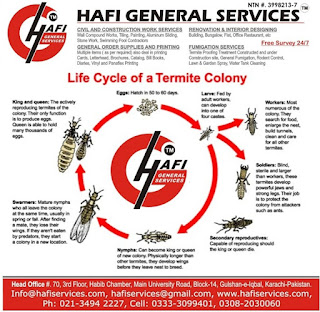 |
| Termite Life Cycle Information |
Termite Life Cycle Information
Basic model of a termite life cycle indicates the three castes, reproductive, soldiers and workers. There are nymphs take part in the social life, and have their specific tasks to fulfill. The so far poorly understood idea of class strength of mind does not seem to be ultimate or too rigid. This procedure is controlled by pheromones. In the case of termite, there is a specific ‘queen’ pheromone prevent other individuals from turning into queens. Only if queen is removed or dies does lack of the specific pheromone promote development of a new queen.
Details of Termite Life Cycle Information
Reproductive Possess:
Reproductive possess compound, eyes and are more or less brown due to their sclerotic cuticle. Developing of reproductive have wing buds, wings or wing stumps. Young winged reproductive’s of both sexes. From time to time about 100 to 1000 alates leave colony for a mating and colonizing flight. After mating a pair settles down at a suitable site. Number of individuals in the colony grows, more workers are available to help young queen, to care for the brood. After three to five years number of individuals is already so large.
King and Queen:
Termite Queen is the main reproductive individuals in a colony. Queen job is only produce a tremendous number of offspring. A large queen may lay more than 1000 eggs per day. Life span of a queen can be as much as 50 years. Why the removal of a queen from her colony does not necessarily mean the end of the colony.
Workers Termite:
Workers are sterile wingless and blind males and females. Termites are confined to a dark and moist environment. Workers build nest and galleries, they fetch food care for the brood. Workers life span is one to two years.
Soldiers Termite:
Soldiers are like workers sterile, wingless and blind males and females with an unpigmented, unsclerotized cuticle. Soldiers defend their colony, from intruders by the use of powerful jaws, or by ejecting a white sticky repellent. Soldiers can’t feed themselves. Usually the number of soldiers is much smaller than the number of workers. Details of Termite Life Cycle Information
Comments
Post a Comment